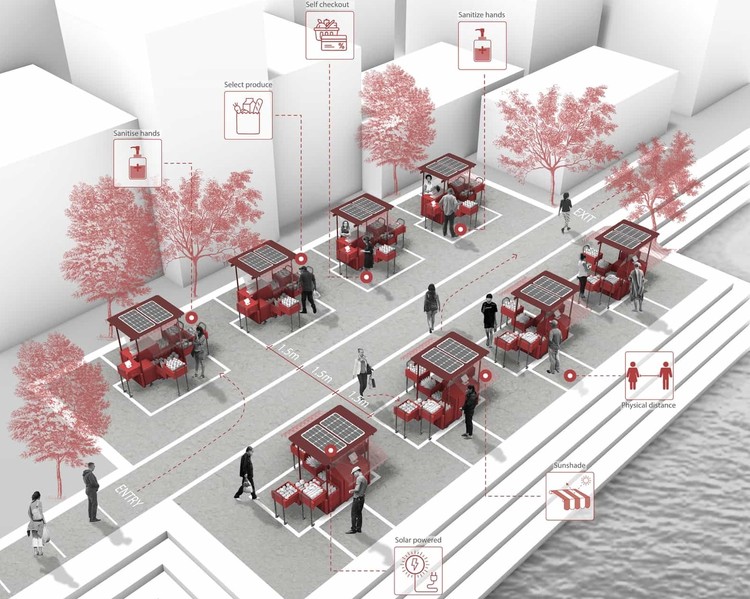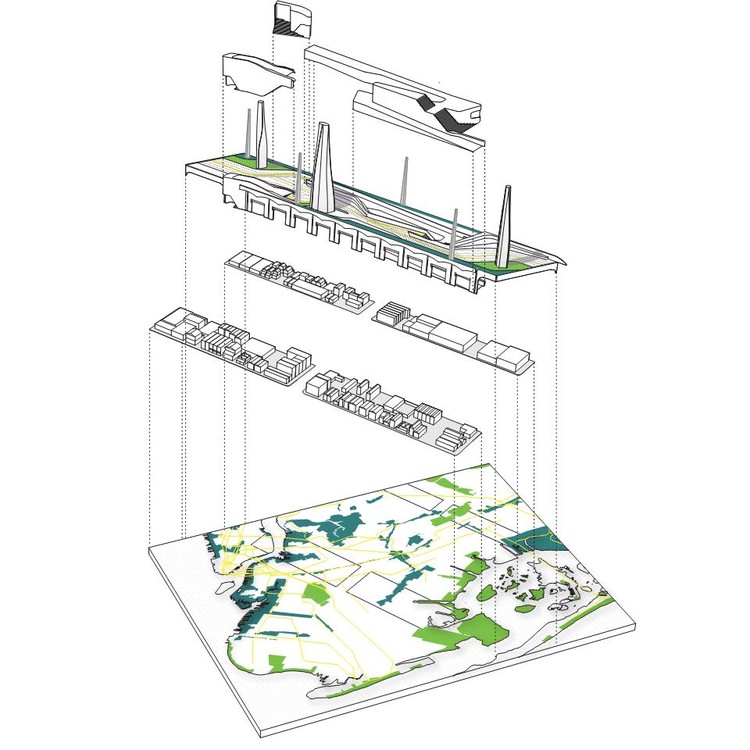
Sharing your shelf is, in a way, sharing yourself. Every element —from the titles you choose to the way you organize them— says something about your personality and your interests.


Sharing your shelf is, in a way, sharing yourself. Every element —from the titles you choose to the way you organize them— says something about your personality and your interests.

Stefano Boeri Architetti has won the international competition for the construction of the largest and most innovative Rehabilitation Centre in Shenzhen, China. With his Chinese office, SBA was selected by a jury composed of local and international figures such as Peter Cook and Sou Fujimoto. Planned to be built in the next three years, the project will put in place “a set of green terraces and overlapping spaces in a sustainable system combining nature, architecture and biodiversity and including internal gardens dedicated to rehabilitation”.

Studio Gang and SCAPE are working in collaboration with Polk Stanley Wilcox Architects on the Arkansas Arts Center currently under construction in MacArthur Park, Little Rock. The work is being realized through a public-private partnership, with a $31 million commitment from the City of Little Rock, funded through a hotel-tax revenue bond. The project will house the Arkansas Arts Center Foundation Collection, which includes 14,000 works of art from around the world.

Ralph Johnson (b. 1948) is a global design director at Chicago-based Perkins and Will. The architect joined the company in 1977 and has been heading its design ideology since 1985. Johnson is the architect behind the firm’s most iconic buildings, including Rush University Transformation Project (2012), O’Hare International Airport (1993), and Boeing International Headquarters (1990) – all in Chicago, the United States Coast Guard Headquarters (2015) in Washington DC, Tinkham Veale University Center at the Case Western Reserve University (2015) in Cleveland, and Shanghai Natural History Museum (2015). The architect’s monographs have been published regularly since mid-1990s under his own name. He has been a visiting critic at the Illinois Institute of Technology and the University of Illinois, his alma mater, from which he received his Bachelor of Architecture in 1971. He acquired his Master of Architecture from Harvard’s GSD in 1973.

Having access to a bathroom is, above all, a factor of dignity. As basic as this fact may seem, the WHO (World Health Organization) estimates that 2 billion people worldwide do not have access to basic sanitation facilities, such as bathrooms or latrines. Such inadequate sanitation causes 432,000 deaths annually, mainly from diarrhea, in addition to being an aggravating factor for several neglected tropical diseases including intestinal worms, schistosomiasis, and trachoma. In 2010, the UN (United Nations) labeled sanitation a basic right, alongside access to drinking water.

Projects for public buildings and infrastructure must always ensure the best possible forms of access and connection with the surrounding streets, particularly regarding access routes for pedestrians. However, some architects have managed to overcome the pragmatic aspect of this connection between architecture and the streets, when designing projects that have a strong duty to provide public space, by using this bond as the core of the design concept.

Koichi Takada has designed a 43-story mixed-use development, in downtown Los Angeles, inspired by “California’s natural beauty and iconic redwoods”. Hoping to create the healthiest place to live in L.A., the proposed building humanizes the concept of high-rise through the use of natural materials, vertical landscaping, engaging public elements, and creating a between artificial and natural environments.

The Atlassian Sydney Headquarters, the soon to be “world’s tallest hybrid timber building” is being built in Sydney, Australia. Designed by SHoP in partnership with BVN, the 40-story high tower will provide, once completed in 2025, a new and innovative space for technology giant Atlassian.

MuseLAB has won the Coronavirus Design Competition hosted by GoArchitect. The competition's challenge was to design a way to help people stay healthy, both in body and mind. The competition was made to recognize that COVID-19 has affected billions of lives, of every nationality, if not physically than economically and mentally.
Ai_Qing_Courtesy_of_KPF.jpg?1592356426)
Architects don’t make buildings. Architects make drawings of buildings. But of course, someone has to make the building. The construction industry is one of the largest economic sectors and we all interact with the built environment on a daily basis, but the actual work of getting a building from drawing to structure has barely evolved over the decades. While the rest of the world has moved into Industry 4.0, the construction sector has not kept pace. Architecture has begun to embrace some digitalization. After all, not many of us work with mylar on drafting tables anymore. So with the architecture industry’s everlasting link to the construction industry, will the latter pick up some new technological tricks by association? And when it does, how will that change the role of the architect?

Feeling free and safe in the city. How many times have we felt fully free when walking through our neighbourhood, when returning home, when sitting in the park? Some urban spaces give us more autonomy than others. Some areas seem more comfortable and calm. But, to keep that calm, to what extent do we express ourselves and to what extent do we hold back? What safeguards do we take to feel as good as possible when inhabiting our environment?

In May, Alphabet’s Sidewalk Labs announced that it would cancel its high-profile Quayside project because of “unprecedented economic uncertainty.” The statement marked the end of a three-year initiative to create a living, urban “testbed for emerging technologies, materials, and processes.”
Reversing the traditional order of city planning, Sidewalk Labs imagined building a new urban district on Toronto’s waterfront from the internet up, with sensors and other data collection infrastructure embedded in the fabric of a large city block. The ambitious development—with an area of 2.65 million square feet, including 1.78 million square feet of residential space—was to be built entirely from mass timber; indeed, the extensive use of modular cross-laminated timber (CLT) and glue-laminated timber (glulam) was a chief selling point of the design (by Heatherwick Studio and Snøhetta, using a kit-of-parts developed by Michael Green Architecture).

Architects in general are people who like to talk about how much they influence communities through their designs, and they are actually correct in saying that. After all, spaces together with various social factors influence how each individual feels when occupying the city or a building. But do these projects respond to all users in the same way? We propose to question the way architecture deals with the LGBTQIA+ community through an open call on our social media channels, bringing in our readers' testimonies on how they experience these spaces, and how is it possible to represent the LGBTQIA+ community in the architectural field.

In 2013, Michael Osborne and Carl Benedikt Frey ranked 702 occupations according to their probability of computerisation in the near future, from least probable (“recreational therapist”) to most probable (“telemarketers”). "Architectural and Engineering Managers” was ranked seventy-third, and “architects” eighty-second, while “architectural and civil drafters” ranked three-hundred and fifth. Clearly, technological advancements in fields such as machine learning and robotics are rapidly confronting us with issues of changing professional demand and qualifications. In this essay, Maurizio Ferraris turns the table on us: what if what we should be concerned with is not maintaining the human element in labor as production, but rather recognising human labor as consumption? Expanding on the arguments of his 2012 book, “Lasciar tracce: documentalità e architettura,” the author sees in automation an extraordinary opportunity in defining a renewed centrality of the human element, as the production of value associated with digital exchange is read through the three concepts of invention, mobilization and consumption.

The most recent edition of The Cathedrals of England brings to a new generation the classic 1930s Batsford guide to England’s religious architecture. Concisely written and speaking to a broad readership, the book serves as a practical guide today as it did almost a century ago, acting as a reference catalogue for every Church of England cathedral in the country at the time.

Across the world, urban clusters have —to a greater or lesser extent— social and economic differences. Reflected in space, these imbalances of income and access to education, health, sanitation, and infrastructure generate ruptures more or less visible —although drastically felt.
Although a daily reality for some, socio-spatial inequalities can often go unnoticed. Photographer Johnny Miller states, "Discrepancies in how people live are sometimes hard to see from the ground... Oftentimes, communities of extreme wealth and privilege will exist just meters from squalid conditions and shack dwellings." Miller's photo series 'Unequal Scenes' seeks "to portray the most 'Unequal Scenes' in [the world] as objectively as possible."

The Midnight Charette is an explicit podcast about design, architecture, and the everyday. Hosted by architectural designers David Lee and Marina Bourderonnet, it features a variety of creative professionals in unscripted conversations that allow for thoughtful takes and personal discussions. A wide array of subjects are covered with honesty and humor: some episodes provide useful tips for designers, while others are project reviews, interviews, or explorations of everyday life and design. The Midnight Charette is also available on iTunes, Spotify, and YouTube.
This week David and Marina are joined by Mabel O. Wilson, Bryan Lee, and Akira Drake Rodriguez to discuss racism and cities, how the built environment can be an instigator of racism, protests, the tearing down confederate monuments, housing, blackness and whiteness, the key changes needed for a more equitable society, and more. Enjoy!

When we hear the term visualization, it’s likely that we picture a flashy render full of lights, people, dazzling finishes, and a sense of energy about the place that we are viewing. Aside from rendering a three-dimensional space, architects also need to develop their skills in the representation of intangible ideas that help drive the narrative behind their arguments. Instead of creating one-off concepts that are presented in a traditionally linear sequence, designers need to craft a story, structure their designs like a thesis, and consider how our presentations have the power to reveal the priorities of a project.

Representation of the real world is, without any doubt, in the genesis of cinema, an art originated from photography, by creating a sequence to convey the impression of movement to the viewer. In fact, the earliest known film recording is from 1895, picturing the arrival of a train at Ciolat station in France, a trivial event in the daily life of 19th-century European cities.
However, even though tangible reality plays a big role in cinema, one cannot ignore that the fascination caused by this art comes, to a great extent, from its capacity to create imaginary worlds, to activate mental spaces, and to unleash emotions. In this sense, the real world may often provide insufficient fuel, inspiration, or background for the directors' and screenwriters' storytelling, so the art direction and scenic design teams are required to create other intangible realities that serve as a basis for the narrative.

The KPF-Designed 601 West Pender Street was granted approval by the Vancouver City Council. Located next to the city’s historic Rogers Building, the project generates an urban oasis within the city, replacing a six-story parking structure in the Central Business District.